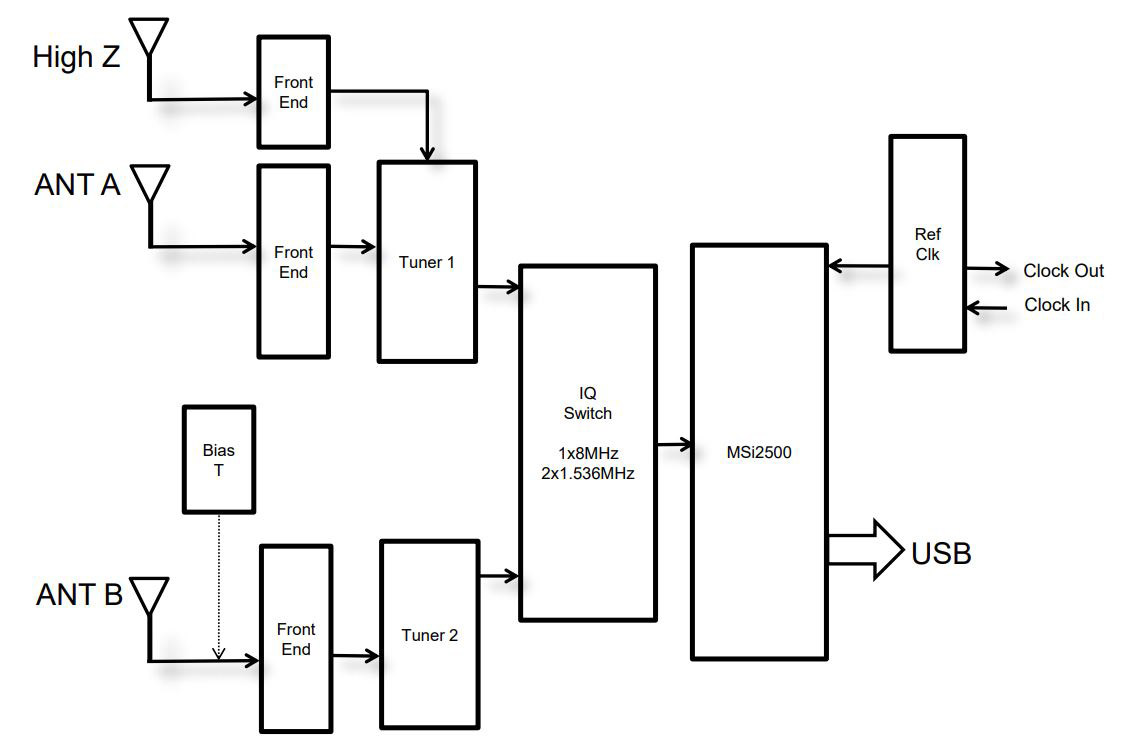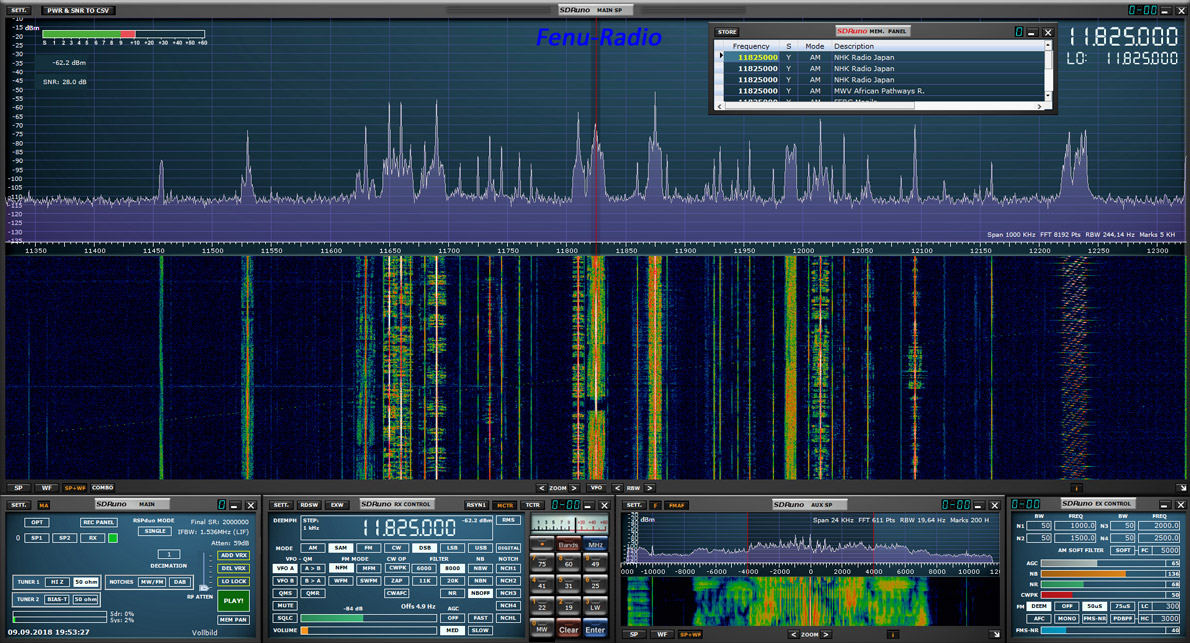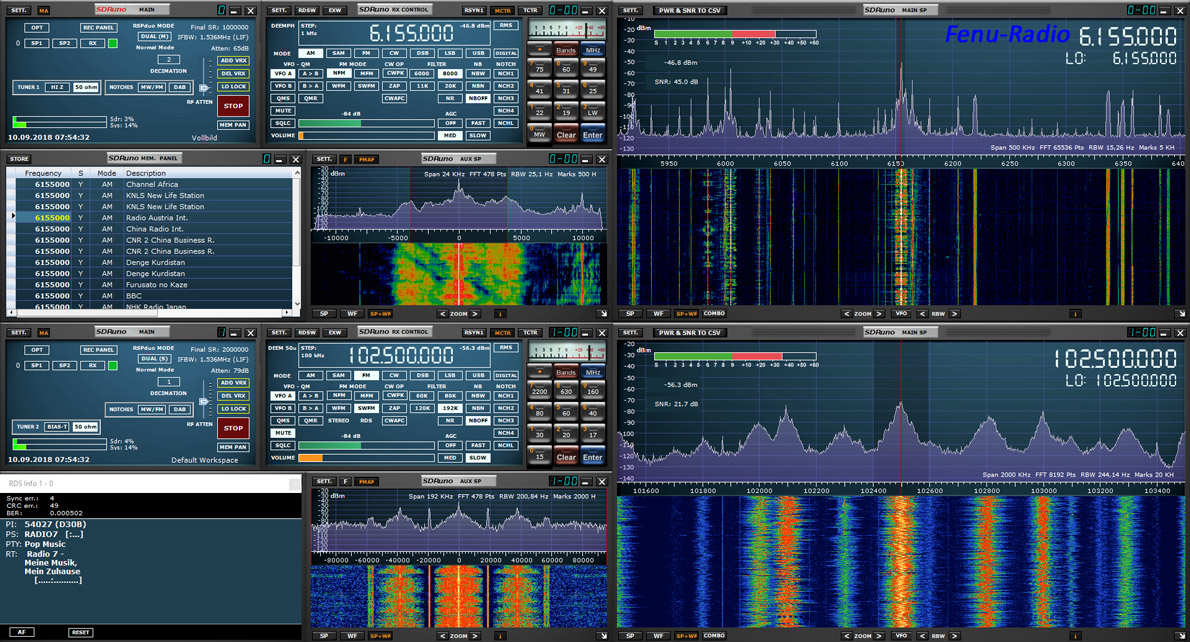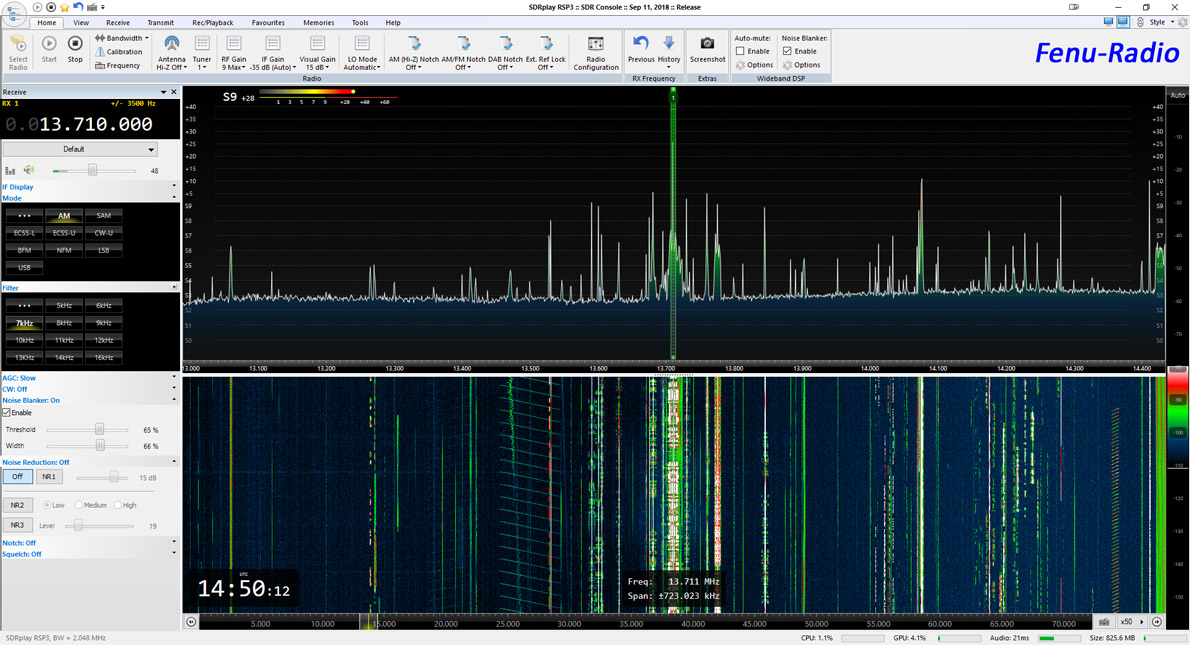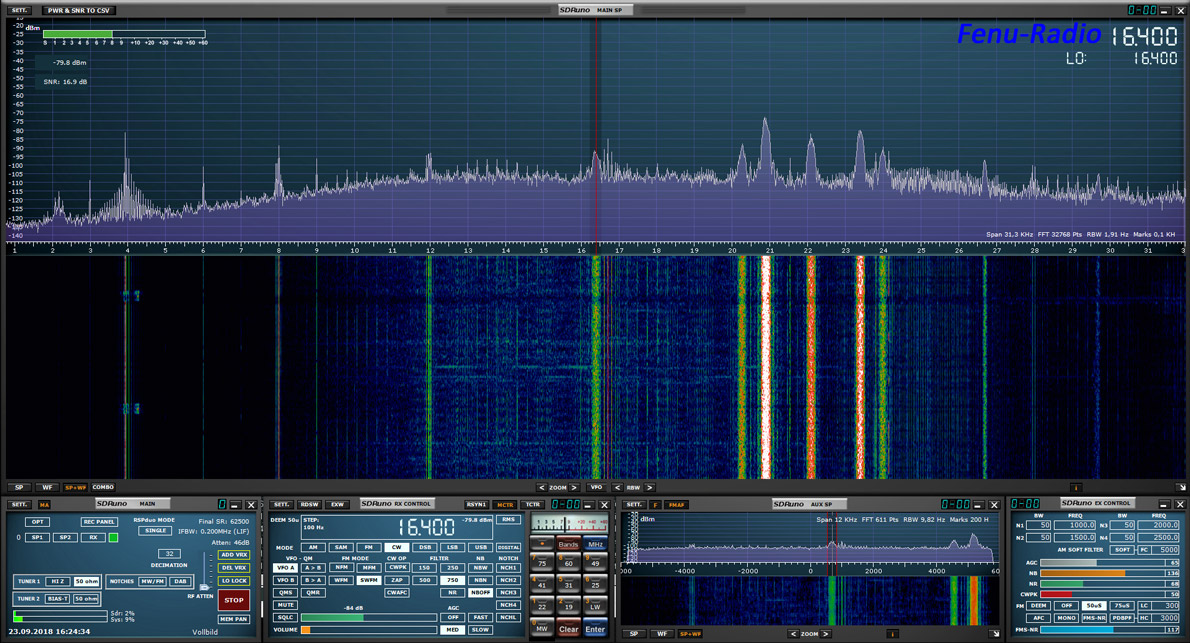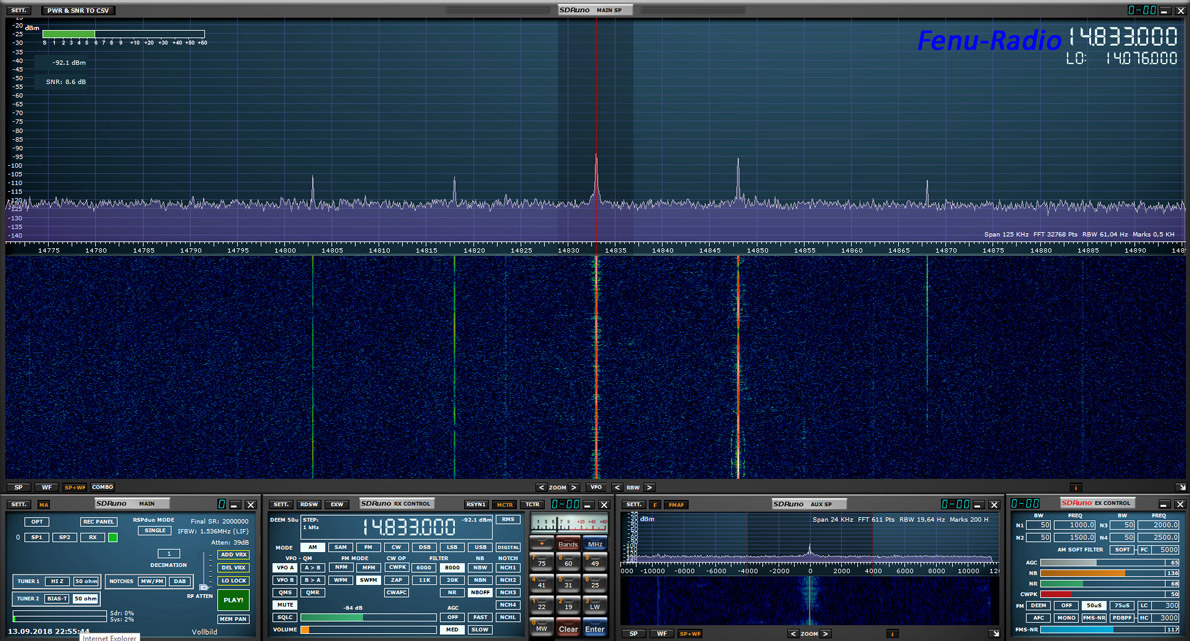|
SDRplay RSPduo
Since June 2018 a special SDR is available. The SDRplay RSPduo. This small black box receiver contains two identical receivers equipped with the Mirics MSi2500 tuner module, which offers continuous reception from 1KHz - 2000MHz. The two receivers in the RSPduo are exactly the same as in the predecessor RSP2pro. Only, they are duplicated. This concept opens up new possibilities in signal monitoring and processing. Jon Hudson from SDRplay, provided me the RSPduo for tests and comparisons.
Functional principle of the
RSPduo The RSPduo is a tuner based receiver, it is not a Direct Sampling SDR such as the Perseus SDR.
There are three antenna inputs in the
RSPduo. Two of them are for the tuner 1. At the "High Z" connection,
high-impedance wire antennas or similar are connected for the
frequency range 1KHz - 30MHz. The signal passes through a 2MHz and a
30MHz lowpass filter as well as a MW / DAB notch. This notch filter
is switchable and suppresses the entire medium wave and the DAB
range to avoid unwanted signals in the shortwave.
The "ANT A" connector is a 50ohm
antenna input and offers the entire frequency range from 1KHz to
2GHz. This is equipped with MW, FM, and DAB notch filters to
attenuate unwanted signals from these frequency ranges. The signal
also passes through various low, high and bandpass filters.
The same with the "ANT B" antenna
input. This is for the tuner 2 and offers the entire frequency range
of 1KHz - 2GHz with the above listed filter options. In addition, a
remote feed path (BiasT) can be activated in the antenna input.
Active antennas can be supplied with an operating voltage of 4.7V. The IQ switch allows operation of a tuner with 8MHz spectrum bandwidth or with both tuners simultaneously with each 1.536MHz spectrum bandwidth. Subsequently, the signal is digitized in the ADC (MSi2500) and passed on to the PC via the USB port, where it can then be processed with the controlprogram. The ADC has a highly stable oscillator (Ref-Clk) connected. This can be externally e.g. be controlled by a GPS receiver.
.
SDRuno control program SDRuno is the original control program of the RSPduo. It is an advanced Version of the well-known Studio1 program, which is no longer updated. SDRuno was mainly optimized for the SDRplay devices and works well with all RSP models. SDRuno consists of several windows that you can place freely on the screen. This compilation can then be saved. A total of ten compilations can be saved. SDRuno provides a standard window compilation in the Options (OPT) menu. The program offers countless functions; Frequency lists can also be integrated in Eibi-CSV or Perseus-Userlist format. Very good is the scalability of the main spectrum. Working with SDRuno is not that easy! Due to the very many functions, a certain amount of training is required. Once this hurdle has been overcome, many possibilities open up and working with SDRuno is really fun. Picture below: SDRuno in Single Tuner Modus
Below: SDRuno in dual mode. Both tuners are active and can receive independently on different frequencies. Very interesting for comparisons. Upper receiver on shortwave 6155KHz, lower receiver on FM 102.5MHz in stereo and with RDS output.
SDR Console V3.03 The RSPduo can also be controlled with the well-known SDR console V3. The V3.03 version shown here only supports one tuner. But the full RSPduo support will coming soon.
Working with the RSPduo The RSPduo is a true broadband receiver that receives up to 2GHz. Since I am mainly concerned with the long, medium and shortwave, I have tested only these frequency ranges in detail. As a comparison device, I primarily used the Winradio G33DDC Excalibur Pro. This is in my opinion the best SDR in the affordable range and is for me the reference receiver. Hobby-usual active antennas were used. The NTi ML200 Loop with 1m diameter, the crossloop also with 2x 1m diameter, the active dipole Datong AD370 and the Stampfl HB9KOC active dipole with a dipol length of 1m. The RSPduo receives at the lowest frequencies with the same sensitivity as the G33DDC !. Both devices brought almost the same level. The lowest frequency a station could hear was at 16.4KHz. Send here Picture below: Reception comparison on submarine frequencies! At 16.4KHz, JXN is available from Norway. Antenna: Datong AD370. On all other frequencies hardly any differences to the G33DDC are noticeable. Only the playback characteristics of the audio can sometimes hear differences. Sometimes one, sometimes the other is better. How does the RSPduo sound in comparison to my reference device, the G33DDC? Audio comparisons say more than words! For the comparison I made audio recordings of the two receivers. The best way to convince yourself, listening to the recordings. When selecting the stations, I have put emphasis on mostly bad receivable stations. Therefore, I recommend to use a headphone while listening to the comparisons.
The only thing, where the RSPduo has to leave springs, is with the strong signal compatibility! During the day virtually no intermodulation was noticed. As soon as evening came and the sum signals increased, unwanted signals were found on frequencies that were supposed to be free. Picture below: Intermodulation in the evening! On frequencies normally not broadcasted by radio stations, the RSPduo regularly brought these unwanted signals! Partly also signal mixtures.
Conclusion: The SDRplay RSPduo is by far more than a shortwave receiver. In conjunction with SDRuno, it is currently the only "dual SDR" that can receive up to 2GHz. The presence of the secondary receiver in the same housing opens up interesting possibilities of frequency monitoring. Also for the future, this combination will be able to offer important functions. The "noise canceling". The hiding of interference signals by phase reversal. Soon, SDRuno will offer this feature. When receiving on VLF, LW, MW and KW the RSPduo is in no way inferior to the reference device G33DDC. Apart from the big signal behavior! Since the G33DDC was absolutely superior. During the day, the RSPduo receives easily. As soon as the evening approaches and the summed signals become stronger, signal mixtures and intermodulation are formed. But considering the low price, that can be overcome. Very good price / performance ratio. posted: 02.10.2018
|

.jpg)
.jpg)
.jpg)
.jpg)

.jpg)
